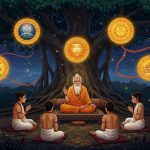
We Hindus address our teachers as a guru from ancient times. The Sanskrit word guru meaning the teacher, mentor, guide, or master. A guru is someone “who dispels the darkness” and “takes us towards the light” by his extreme wisdom and knowledge. A wise teacher will teach a student traditional values, morality, the meaning of life, and will share his knowledge. He will inspire the students and helps in their spiritual evaluation.
In Vedic times, there were no infrastructural contemporary schools. At that time, students used to go to ‘Gurukuls’– ran by Gurus. Gurukul is the guru’s (teacher’s) house. In this education system, students need to stay at the guru’s place or near the guru for years. They had to live a well-maintained and systematic life there. They discuss and gain knowledge about everything in the universe, about karma, cosmic science, spirituality, etc. At the end of the education, shishya (student) offers “Dakshina” (Guru-Dakshina) to the guru before leaving the gurukul.
Now you understand, a guru wasn’t someone who only teach something from notebooks by following the so-called study structure. In Vedic-Shastras and Upanishads, a guru is addressed as an ancient and central figure.
A guru is wise, skillful, and counselor. Gurus acquired vast cosmology through their pursuit. Hence, Hindus could achieve liberation, contentment, moksha, and find inner-perfection by following the path of their gurus.
Guru is an ideology, a historic and reverential person to us. In Hindu culture, he is an important character who helps us to grow spiritually.
Feature Image Source: https://commons.wikimedia.org/wiki/File:Parmarth4.jpg
Parmarth Niketan Ashram / Public domain




